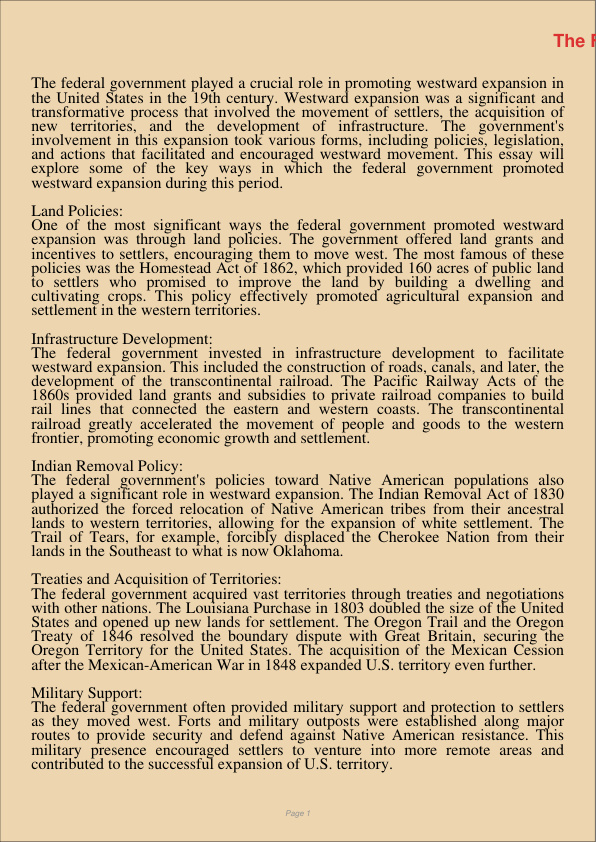The Federal Government Promoted Westward Expansion In A Variety Of Ways
Jan 8, 2024
federal government promoted westward expansion
ways
Nursing
Social science
The federal government played a crucial role in promoting westward expansion in the United States in the 19th century. Westward expansion was a significant and transformative process that involved the movement of settlers, the acquisition of new territories, and the development of infrastructure. The government’s involvement in this expansion took various forms, including policies, legislation, and actions that facilitated and encouraged westward movement. This essay will explore some of the key ways in which the federal government promoted westward expansion during this period.
Land Policies: One of the most significant ways the federal government promoted westward expansion was through land policies. The government offered land grants and incentives to settlers, encouraging them to move west. The most famous of these policies was the Homestead Act of 1862, which provided 160 acres of public land to settlers who promised to improve the land by building a dwelling and cultivating crops. This policy effectively promoted agricultural expansion and settlement in the western territories.
Infrastructure Development: The federal government invested in infrastructure development to facilitate westward expansion. This included the construction of roads, canals, and later, the development of the transcontinental railroad. The Pacific Railway Acts of the 1860s provided land grants and subsidies to private railroad companies to build rail lines that connected the eastern and western coasts. The transcontinental railroad greatly accelerated the movement of people and goods to the western frontier, promoting economic growth and settlement.
Indian Removal Policy: The federal government’s policies toward Native American populations also played a significant role in westward expansion. The Indian Removal Act of 1830 authorized the forced relocation of Native American tribes from their ancestral lands to western territories, allowing for the expansion of white settlement. The Trail of Tears, for example, forcibly displaced the Cherokee Nation from their lands in the Southeast to what is now Oklahoma.
Treaties and Acquisition of Territories: The federal government acquired vast territories through treaties and negotiations with other nations. The Louisiana Purchase in 1803 doubled the size of the United States and opened up new lands for settlement. The Oregon Trail and the Oregon Treaty of 1846 resolved the boundary dispute with Great Britain, securing the Oregon Territory for the United States. The acquisition of the Mexican Cession after the Mexican-American War in 1848 expanded U.S. territory even further.
Military Support: The federal government often provided military support and protection to settlers as they moved west. Forts and military outposts were established along major routes to provide security and defend against Native American resistance. This military presence encouraged settlers to venture into more remote areas and contributed to the successful expansion of U.S. territory.
Surveying and Mapping: The federal government conducted extensive surveys and mapping of western lands. The General Land Office and the Bureau of Land Management were responsible for dividing and distributing land, making it accessible for purchase and settlement. These efforts helped potential settlers navigate the vast, unfamiliar terrain.
In conclusion, the federal government’s promotion of westward expansion was multifaceted and had a profound impact on the growth and development of the United States. Land policies, infrastructure development, the acquisition of new territories, policies toward Native Americans, and military support were all instrumental in encouraging westward movement. This expansion not only shaped the nation’s physical boundaries but also influenced its culture, economy, and identity.
